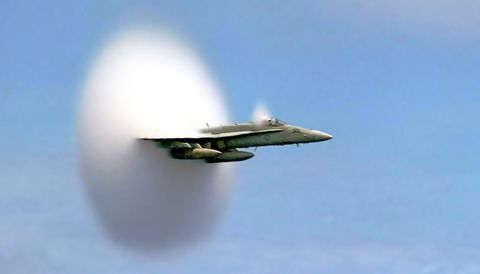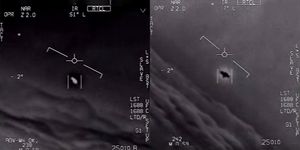Ex-Intelligence Director confirms Navy and Air Force pilots have seen “difficult-to-explain,” “hard-to-replicate” objects.

- Former Director of National Intelligence John Ratcliffe told Fox News the Pentagon has many reports about unidentified aerial phenomena (UAP), including UFO sightings that haven’t been made public.
- Ratcliffe said the reports contain sightings of objects making movements that “are hard to replicate” and “traveling at speeds that exceed the sound barrier without a sonic boom.”
- By law, the Pentagon must report more information on UFO sightings in June.
A former U.S. intelligence official recently revealed the Pentagon is sitting on “lots of reports” about what it officially calls unidentified aerial phenomena (UAP), better known as unidentified flying objects (UFOs).
John Ratcliffe, who served as the Director of National Intelligence Community from May 2020 to January 2021, told Fox News’s Maria Bartiromo on Friday the reports include sightings of objects that “frankly engage in actions that are difficult to explain.” Ratcliffe said both U.S. Navy and Air Force pilots and satellite imagery have spotted the UAP.
The objects reportedly made “movements that are hard to replicate that we don’t have the technology for, or traveling at speeds that exceed the sound barrier without a sonic boom,” Ratcliffe said. “In short, things that we are observing that are difficult to explain.”
When an aircraft increases its speed, pressure waves build up on it and eventually coalesce into a single shockwave. When the plane outruns that shockwave and travels faster than the speed of sound in air, it causes a sudden change in pressure, which in turn creates the sonic boom. There’s no publicly available scientific data to suggest any aircraft can break the sound barrier without producing a sonic boom; while engineers can take steps to try to reduce sonic booms, physics says it’s impossible to outright eliminate it.
Ratcliffe admitted the Pentagon simply can’t rationalize some of the reported sightings:
“We always look for a plausible explanation. You know, weather can cause disturbances, visual disturbances, sometimes we wonder whether or not our adversaries have technologies that are a little bit further down the road than we thought or that we realized. But there are instances where we don’t have good explanations for some of the things that we’ve seen.”
Ratcliffe told Bartiromo he wanted to “get this information out and declassify it” before he left office in January, when Donald Trump’s presidential administration gave way to Joe Biden’s. “But we weren’t able to get it down into an unclassified format that we could talk about quickly enough,” Ratcliffe said.
It’s unclear why Ratcliffe has decided to speak out about UAP now, although the former Director of Intelligence’s remarks may foreshadow a major report the Pentagon is set to release in the coming months. Indeed, 2021 promises to be one of the most significant years ever for the advancement of UFO disclosure—and that follows a year in which the U.S. Navy officially released three videos that show UFOs are genuine.
In August 2020, the Department of Defense (DoD) officially approved the establishment of an Unidentified Aerial Phenomena Task Force (UAPTF). The task force will investigate the sightings of UAP.
The UAPTF is the first official government program affiliated with UFO research since a 2000s-era unit that analyzed unmanned aerial vehicles (UAVs) and other UAP lost its funding in 2012, even though multiple sources confirmed with Popular Mechanics that the unit remained active in secrecy after its shuttering.
The DoD formed the UAPTF to “improve its understanding of, and gain insight into, the nature and origins of [UAP],” Pentagon spokesperson Sue Gough told Popular Mechanics at the time. “The mission of the task force is to detect, analyze, and catalog [UAP] that could potentially pose a threat to U.S. national security.”
In June 2020’s Intelligence Authorization Act (IAA), the Senate Select Committee on Intelligence (SSCI) authorized appropriations for fiscal year 2021 for the UAPTF and supported its efforts to reveal any links that UAP “have to adversarial foreign governments, and the threat they pose to U.S. military assets and installations.”
In the IAA, the Select Committee on Intelligence said it “remains concerned that there is no unified, comprehensive process within the federal government for collecting and analyzing intelligence on [UAP], despite the potential threat,” and so it directed the task force to report its findings on UAP, “including observed airborne objects that have not been identified,” within 180 days.
When Trump signed the coronavirus relief and government funding bill into law in December 2020, it contained the IAA for Fiscal Year 2021, which means the UAPTF must report its findings to Congress by June 25.
While we don’t know what the task force will reveal in its first report, Ratcliffe’s remarks could offer hints. It’s noteworthy, for example, that he mentioned both U.S. Navy and Air Force pilots’ encounters with UAP. The Navy, of course, has confirmed three videos taken by Navy pilots show UAP, but the service also said the footage should have never been released to the public in the first place.
The Air Force, on the other hand, has largely been quiet regarding UAP. A former Director of National Intelligence’s admission that the Air Force has also seen UAP is significant, and may suggest the service plays a larger role in the forthcoming UAPTF report.
Additionally, Ratcliffe emphasized the Pentagon’s documented UAP sightings go beyond “just a pilot or just a satellite, or some intelligence collection,” he said. “Usually, we have multiple sensors that are picking up on these things.”
That tracks with what government officials who have access to such documents revealed to The Debrief last year: “Some of the best evidence acquired has come from measurement and signature intelligence (MASINT), rather than from videos or still images,” one source told The Debrief’s Tim McMillan, a contributor to Popular Mechanics.
While we wait to see what’s in the UAPTF’s report, Ratcliffe made it clear to Bartiromo that he’s just as eager for disclosure as the public is.
“I think it will be healthy for as much of this information to get out there as possible so that the American people can see some of the things that we’ve been dealing with,” he said.










0 comments:
Post a Comment